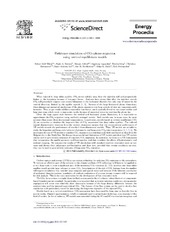| dc.description.abstract | When injected in deep saline aquifers, CO2 moves radially away from the injection well and progressively higher in the formation because of buoyancy forces. Analyzes have shown that after the injection period, CO2 will potentially migrate over several kilometers in the horizontal direction but only tens of meters in the vertical direction, limited by the aquifer caprock. Because of the large horizontal plume dimensions, three-dimensional numerical simulations of the plume migration over long periods of time are computationally intensive. Thus, to get results within a reasonable time frame, one is typically forced to use coarse meshes and long time steps which result in inaccurate results because of numerical errors in resolving the plume tip. Given the large aspect ratio between the vertical and horizontal plume dimensions, it is reasonable to approximate the CO2 migration using vertically averaged models. Such models can, in many cases, be more accurate than coarse three-dimensional computations. In particular, models based on vertical equilibrium (VE) are attractive to simulate the long-term fate of CO2 sequestered into deep saline aquifers. The reduced spatial dimensionality resulting from the vertical integration ensures that the computational performance of VE models exceeds the performance of standard three-dimensional models. Thus, VE models are suitable to study the long-time and large-scale behavior of plumes in real large-scale CO2-injection projects. We investigate the use of VE models to simulate CO2 migration in a real large-scale field case based on data from the Sleipner site in the North Sea. We discuss the potential and limitations of VE models and show how VE models can be used to give reliable estimates of long-term CO2 migration. In particular, we focus on a VE formulation that incorporates the aquifer geometry and heterogeneity, and that considers the effects of hydrodynamic and residual trapping. We compare the results of VE simulations with standard reservoir simulation tools on test cases and discuss their advantages and limitations and show how, provided that certain conditions are met, they can be used to give reliable estimates of long-term CO2 migration. | en_US |

